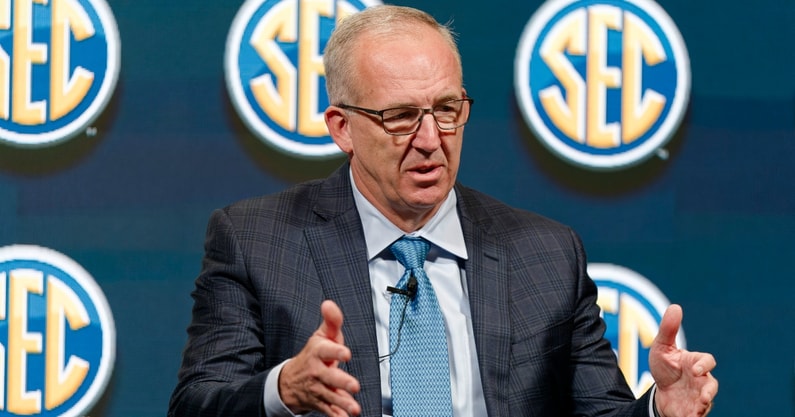Greg Sankey explains complexities around NCAA's evolving transfer portal windows

A few years into the new wide-open rules for the transfer portal, many coaches and folks in leadership throughout college sports have a laundry list of complaints with the system and many suggestions for how to fix it. Perhaps no figure has been more front and center on NIL and transfer discussions than SEC commissioner Greg Sankey, who has shared consistent and strong views on both issues at SEC Media Days this week.
Sankey even had a moment to stop by and chat about the transfer portal with JD PicKell, who’s down in Nashville representing On3 on press row. During his pit stop by the On3 table, PicKell asked Sankey… in a perfect world, what would he change about the current state of the transfer portal. As he typically does, the SEC commissioner issued a detailed, multi-step answer on the situation, where he pleads for even more shortened windows for when athletes can actually access the portal.
You can read that full response right here:
SEC commissioner Greg Sankey lays out current issues with transfer portal rules
“I would not have had both events layered on each other immediately. It’s like going to the doctor and being prescribed two medicines when you’re ill and you don’t know which one helped you. You know, that’s not the way medicine works, but that’s the way NIL and transfer freedom has happened.
“So let’s go back. We had COVID, we had a move to a one-time transfer exception that was going to apply to all sports. Remember back five years ago, five sports all served a year of residence and every other sport had a one-time transfer exception where you could transfer and play right away. But there was a level of control in there that had to be reconsidered.
Top 10
- 1Breaking
Pop Isaacs
Creighton guard commits to Houston
- 2
Final AP Poll
Basketball Top 25 released
- 3Hot
Way-Too-Early Top 25
Looking ahead to 2025-26 hoops
- 4
Nick Saban
Nominated for Emmy
- 5Trending
Hailey Van Lith
Stuns as SI Swimsuit cover model
Get the On3 Top 10 to your inbox every morning
By clicking "Subscribe to Newsletter", I agree to On3's Privacy Notice, Terms, and use of my personal information described therein.
“Then in the interim, around COVID-era, there was no one-time transfers, there was no expectation of timing for declaration. So post-COVID, the NCAA has been directed to move back to the one-time transfer exception. So a young person has one opportunity to say, ‘you know what, I want to go somewhere else and play right away. I think that can be educationally sound.
“There’s also been clear messaging from the NCAA to get out of this waiver business, and I hope that will take place. The reality was there was a 365-day transfer portal declaration window. That’s now narrowed to 60 days. I think that should be shortened greatly. I think it went on too long. We need to do something. We addressed it by going from 365 down to 60. The research shows that young people, in the first 10 days, in the majority of circumstances, are deciding whether to enter the transfer portal or not.
“Lastly, we have to be attentive to the educational outcomes that are impacted by transfers. You actually reduce the likelihood of graduation. When you transfer, you lose credits. The more you transfer the more you inhibit the likelihood of graduation. And we need to be mindful over time of what’s actually happening, because we are engaged in an educational endeavor. This is not all about transferring and accessing playing time.”